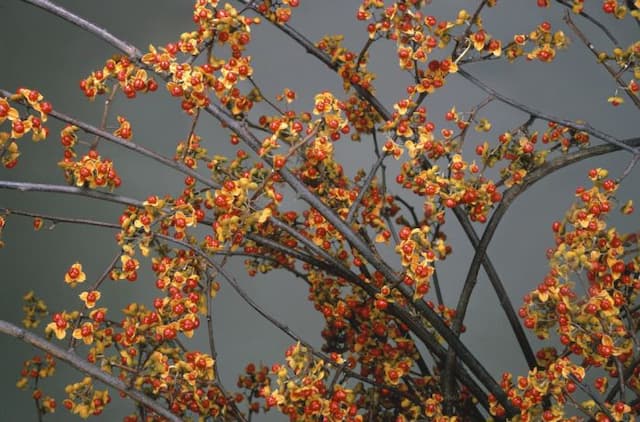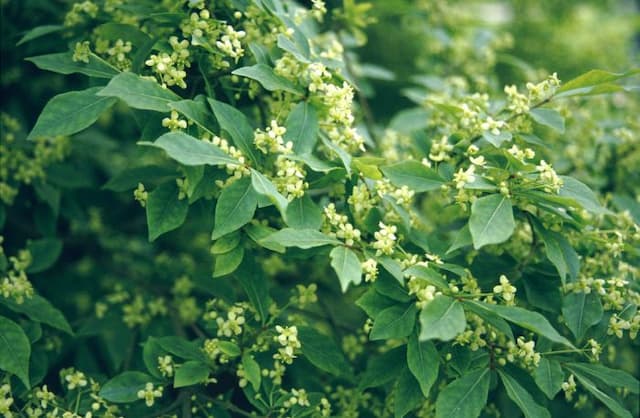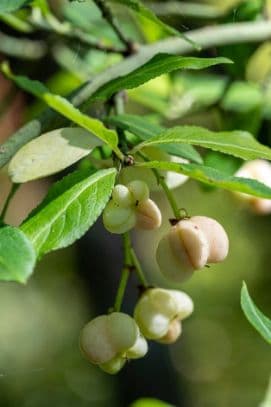Canadale Gold Wintercreeper Euonymus fortunei 'Canadale Gold' (v)

ABOUT
Euonymus fortunei 'Canadale Gold' commonly known as Wintercreeper, is a variegated plant that is admired for its decorative foliage. The leaves are glossy and exhibit a distinctive color pattern, with a green center and margins that are painted with a golden-yellow hue. This coloration provides a striking contrast that can brighten up any garden space. The leaves are oval-shaped with a slightly toothed edge, which adds texture to the plant's overall appearance. Wintercreeper is an evergreen, meaning it retains its foliage year-round. This renders it an excellent choice for gardeners looking to maintain some color through the winter months. The plant's growth habit is versatile, it can be trained to climb as a vine or trimmed to maintain as a shrub. It's the vibrant, two-toned leaves that truly characterize this plant and make it a popular choice for ornamental landscaping.
About this plant
 Names
NamesFamily
Celastraceae
Synonyms
Canadale Gold Wintercreeper, Canadale Gold Euonymus, Fortune's Spindle, Wintercreeper, Gold-leaf Wintercreeper
Common names
Euonymus fortunei 'Canadale Gold'
 Toxicity
ToxicityTo humans
Wintercreeper is considered to be toxic if ingested by humans. Its leaves, berries, and other parts contain compounds that can be harmful. Ingesting parts of the plant can result in symptoms such as nausea, vomiting, diarrhea, weakness, and chills. Contact with the sap may also cause skin irritation or allergic reactions in some individuals. The severity of the consequences can vary based on the amount ingested and the sensitivity of the individual.
To pets
Wintercreeper is toxic to pets, including dogs and cats, if ingested. The ingestion of leaves, berries, or other parts of the plant can lead to symptoms including vomiting, diarrhea, abdominal pain, and weakness. In severe cases, ingestion could potentially result in more serious consequences, including heart rhythm problems, though this is less common. The severity can vary depending on the amount consumed and the size and health of the pet.
 Characteristics
CharacteristicsLife cycle
Perennials
Foliage type
Evergreen
Color of leaves
Variegated
Height
2-4 feet (0.6-1.2 meters)
Spread
4-6 feet (1.2-1.8 meters)
Plant type
Shrub
Hardiness zones
5-9
Native area
East Asia
Benefits
 General Benefits
General Benefits- Attractive Foliage: The Canadale Gold Wintercreeper has variegated leaves that provide visual interest and contrast in the garden throughout the year.
- Low Maintenance: This plant requires minimal care once established, making it a convenient choice for gardeners of all skill levels.
- Ground Cover: It can be used effectively to cover bare spots in the landscape, control erosion, and suppress weeds.
- Versatile Use: The Wintercreeper can be trained to climb structures or left to trail over walls and banks.
- Drought Tolerance: Once established, it exhibits some drought tolerance, reducing the need for frequent watering.
- Adaptability: It can grow in a wide range of soil types and conditions, from full sun to partial shade.
- Year-Round Interest: Its evergreen leaves provide color and interest in the garden even during the winter months.
- Wildlife Habitat: Though not its main purpose, it can provide shelter for small wildlife and insects.
- Privacy: When trained to grow on trellises or fences, it can act as a living screen, offering privacy to outdoor spaces.
- Hardiness: It is a hardy plant that can withstand cold temperatures, making it suitable for a variety of climates.
 Medical Properties
Medical PropertiesThis plant is not used for medical purposes.
 Air-purifying Qualities
Air-purifying QualitiesThis plant is not specifically known for air purifying qualities.
 Other Uses
Other Uses- Wintergreen Euonymus can be used in container gardens to add foliage interest, especially when combined with annuals and perennials that prefer cooler temperatures.
- It can serve as a living Christmas decoration when its branches are strewn with fairy lights, thanks to the plant's evergreen nature and variegated leaves.
- This plant's dense growth habit makes it a suitable choice for topiary or other forms of plant shaping and sculpting.
- The hardy nature of Wintergreen Euonymus allows it to be used in erosion control on slopes or banks as its roots help to stabilize the soil.
- They can be planted as a natural green backdrop in outdoor photography settings, creating a consistent and neutral background for portraits.
- The attractive foliage of the Wintergreen Euonymus could be used for festive garlands or wreaths during the holiday seasons.
- With its adaptability, it can be crafted into a living fence or privacy screen, providing both beauty and function in a landscape.
- Its variegated leaves may be used in floral arrangements as filler foliage to add contrast and interest.
- Wintergreen Euonymus, being resilient to many conditions, can be used in urban landscaping to provide greenery in harsh city environments.
- Similarly sized and shaped hedge maze installations or garden partitions can be created with this plant, due to its ease of trimming and dense growth.
Interesting Facts
 Feng Shui
Feng ShuiWintercreeper is not used in Feng Shui practice.
 Zodiac Sign Compitability
Zodiac Sign CompitabilityWintercreeper is not used in astrology practice.
 Plant Symbolism
Plant Symbolism- Hardiness: Euonymus fortunei 'Canadale Gold', commonly known as Wintercreeper, is known for its ability to survive in tough conditions, so it symbolizes strength and endurance.
- Versatility: This plant can grow in various environments, from full sun to shade, symbolizing adaptability and resilience.
- Growth: As a fast-growing plant, the Wintercreeper represents rapid development and expansion, whether it be in one's personal life or career.
- Protection: The dense foliage of the Wintercreeper can create a barrier, symbolizing safety and privacy.
 Water
WaterCanadale Gold Wintercreeper should be watered regularly to maintain moist soil conditions, especially during the first growing season to establish a deep, extensive root system. Once established, it is somewhat drought-tolerant. In the absence of rainfall, water the plant deeply once a week, providing about 1-2 gallons of water per plant, depending on the size and environmental conditions. Always ensure the soil is not waterlogged, as this can cause root rot. During the winter months, reduce watering frequency as plant needs decrease.
 Light
LightCanadale Gold Wintercreeper thrives in a variety of light conditions, from full sun to partial shade, but it displays the best foliage color in full sun to partial shade. A location with morning sunlight and afternoon shade is ideal. Avoid deep shade as it may lead to less vibrant foliage and a more open growth habit.
 Temperature
TemperatureCanadale Gold Wintercreeper is hardy and can tolerate a wide range of temperatures. It prefers temperatures between 60°F to 80°F but can survive in temperatures as low as 0°F and as high as 100°F. This plant is well-suited for USDA hardiness zones 5 through 9, reflecting its adaptability to various climates.
 Pruning
PruningPrune Canadale Gold Wintercreeper to shape it and control its size, as it can become invasive if not managed. The best time for pruning is in late winter or early spring before new growth begins. This plant can be pruned as often as needed to maintain the desired shape and size. Regular pruning also encourages bushier growth and a more attractive appearance.
 Cleaning
CleaningAs needed
 Soil
SoilWintercreeper prefers well-drained soil rich in organic matter with a soil pH range of 6.0 to 7.5. A mix of garden soil, compost, and peat or pine bark can create an ideal growing medium.
 Repotting
RepottingWintercreeper should be repotted every 2 to 3 years to ensure it continues to thrive in fresh soil and has room for root growth.
 Humidity & Misting
Humidity & MistingWintercreeper tolerates a wide range of humidity levels but prefers average to high humidity, without requiring any special care to maintain it.
 Suitable locations
Suitable locationsIndoor
Use well-draining soil, place it in bright indirect light.
Outdoor
Plant in partial shade to full sun, in well-draining soil.
Hardiness zone
4-9 USDA
 Life cycle
Life cycleThe evergreen shrub known as Canadale Gold Wintercreeper (Euonymus fortunei 'Canadale Gold') begins its life cycle as a seedling, emerging from dispersed seeds in suitable growing conditions, which usually include partial to full sunlight and well-drained soil. After germination, it enters a juvenile vegetative stage, where it focuses on establishing a robust root system and lush foliage, characterized by green and gold variegated leaves. Once mature, it can start to spread both by climbing surfaces with its aerial rootlets and creeping along the ground, a stage that leads to significant coverage and can last for several years. The mature plant may occasionally produce small, inconspicuous flowers in the summer, followed by seeds contained in pinkish-red fruits in the fall, completing the reproductive cycle. These seeds then have the potential to give rise to new seedlings, perpetuating the population of Canadale Gold Wintercreeper in the area. Throughout its life cycle, this plant may be pruned to manage its growth or propagated through cuttings to produce genetically identical clones for cultivation.
 Propogation
PropogationPropogation time
Spring-Early Summer
Propogation: The Wintercreeper 'Canadale Gold' is commonly propagated by stem cuttings. The best time to take cuttings for propagation is during the late spring or early summer when the plant is actively growing. To propagate using stem cuttings, a gardener should select a healthy, non-flowering shoot and cut a 4 to 6-inch (10 to 15 cm) section, making sure to include several leaf nodes. The lower leaves are removed, and the cut end is often dipped in rooting hormone to encourage root development. This prepared cutting is then planted in a well-draining potting mix, ensuring that at least one or two nodes are buried in the soil. The cutting needs to be kept moist and in a warm, bright place but out of direct sunlight until roots have developed, which usually takes several weeks. Once rooted, the new Wintercreeper plants can be transplanted to their final location.




![Spindle [Blondy]](/_next/image?url=https%3A%2F%2Fplants-admin.emdemapps.com%2Fimages%2Fplants%2F%2Fimages%2F604b642f54add.png&w=640&q=75)



